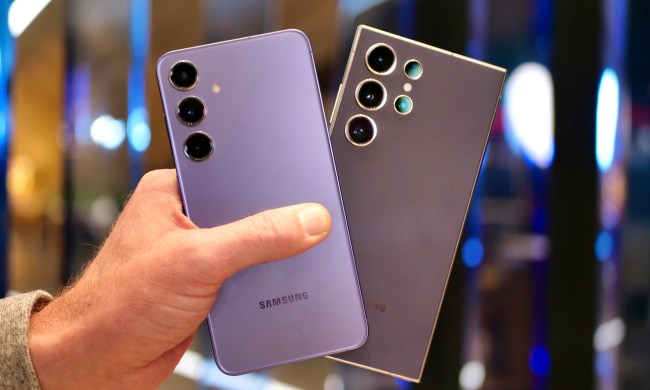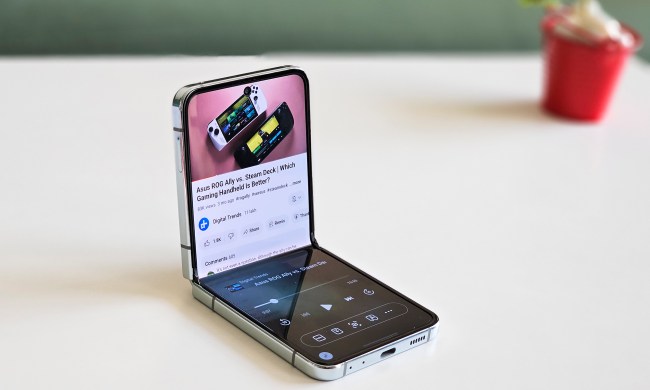Native Union is an accessory company that places an emphasis on style. Whether it’s a cool case or some neat cables, its products often stand out from the crowd of tech accessory makers. The Eclipse Charger is one of its latest products, and it’s a multi-device charging hub that’s far more complex than most other products we’ve seen from the company. The Eclipse Charger started out as a crowd-funding campaign, and we take a closer look in our review to see whether or not it’s worth the high price tag.
Heavy, but minimal
The Eclipse Charger’s design will split opinion. We like its simplicity and the inclusion of Native Union’s usual fabrics, but we’ve gradually come to consider it a little large and heavy. Its circular, moon-like top down view is attractive, but it’s quite bulky when you look at it from the side. For a device made to reduce clutter, it has a large footprint, and that may put some people off.
The Eclipse holds three USB charging cables inside, keeping them neatly wrapped around the central, motorized drum section. Double tap the top of the Eclipse and it rises up, revealing your cables and connectors. The idea is to extract just enough of the one you need, plug it in to your device, and double tap the flat top again to lower the center back into place.
Before you get to this stage, you’ll need to “build” the Eclipse when you take it out of the box. Add each cable you want to use through the central screwhead-style stack. There are three ports that manage power, delivering faster than normal charging, but the Eclipse does not support technology like Qualcomm’s Quick Charge. There are three USB Type-A ports with 2.4A, and a USB Type-C port with 3A hidden inside. Wrapping the cables up wasn’t the hard part, but getting the central unit reattached to the base took a lot of force — to the point where we were afraid it would break. Thankfully, it eventually snapped into place.
Charge all the devices
We chose to feed in an Apple Lightning cable, a USB Type-C cable, and our Apple Watch charging disc. The two phone chargers neatly hide away inside the Eclipse, but the channels inside the central section aren’t big enough for the Apple Watch charging disc, so it flops around outside. It doesn’t affect use, but it’s not the prettiest solution. To be fair to Native Union, it states this fact quite clearly in its FAQ.
For a device made to reduce clutter, it has a large footprint.
We experienced no problems charging all of our devices — individually or all together. The Eclipse has surge protection along with smart power management, so it delivers the maximum power to devices that will take it. We didn’t notice it getting hot, or any other negative effects.
The Eclipse easily performs its main function — a stylish cable management solution — effectively. Three cables spread over a bedside table or on a desk is unsightly and a little dangerous. The Eclipse completely solves this problem. The Eclipse itself isn’t much of a space-saver though. It’s a substantial round plinth, and takes up a fair amount of room on a small table. There is the option to wall-mount the whole thing, which may be preferable; but this means winding the cables up again when you’re done to keep it neat, which defeats the Eclipse’s simplicity.
How about the motorized top? It’s a little gimmicky, but in a good way. Sure, a spring release system would have done the same job, but it wouldn’t be as neat or as fun. The double tap to raise and lower the cable management drum is easy to remember and works almost every time, although you do have to be quite precise with the timing of your taps. A single tap on the top turns on a small ambient light under the Eclipse — showing the inspiration for its name — that gives off a small glow. It’s no reading light, sadly, and outside of looking quite cool, it serves no purpose.
Colorful variants
Native Union is as much about style as it is about functionality and technology, so it’s no surprise to find several different color and material choices for the Eclipse. The model we reviewed has fabric, which is available in three colors. There are two wooden options and a more expensive marble edition. Native Union loves marble, as we’ve seen before on its iPhone cases.
Now if only the top part was a wireless charging pad too.
The fabric Eclipse chargers cost $80, the wooden ones are $100, and the marble model is $160. In the U.K., the Eclipse with fabric is 70 British pounds, the wood models are 90 British pounds, and the marble version is yours for 140 British pounds. Native Union also has various charging cables in matching color schemes, if you want to coordinate the entire setup. Everything can be purchased through Native Union’s own website.
The Eclipse is a smart, stylish, and well-designed cable management and charging system for your various gadgets. It’s versatile because you use your own cables, but the downside is it’s quite large, so don’t expect it to melt away into the background. Now if only the top part was a wireless charging pad too, we’d be overjoyed.








